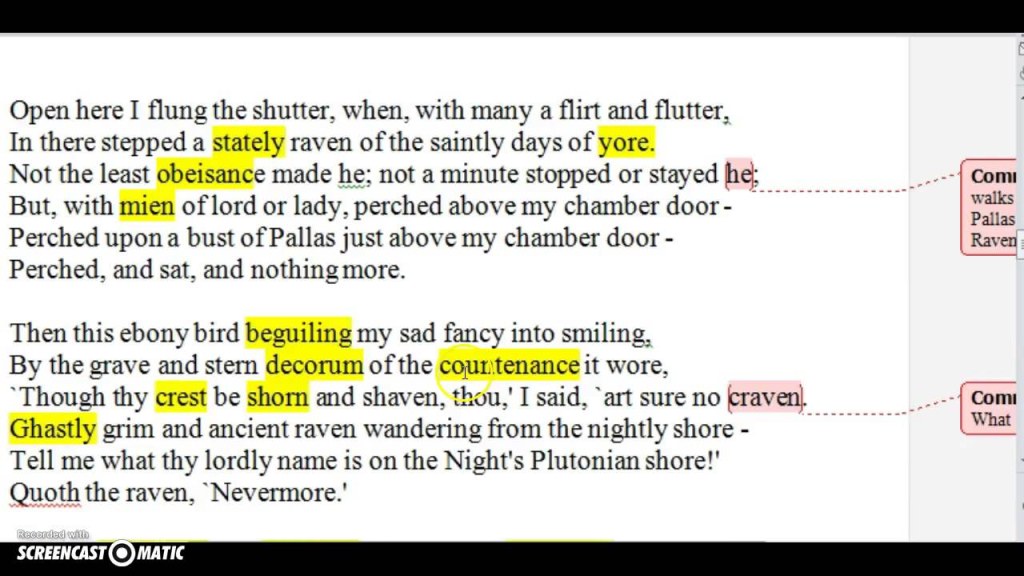The Raven Annotations: Dive Into The Enigmatic Tale With Expert Insights – Uncover The Hidden Secrets Now!
The Raven Annotations: Unveiling the Secrets of Edgar Allan Poe’s Masterpiece
Introduction
Welcome, Raven Enthusiasts! Today, we delve into the enigmatic world of The Raven by Edgar Allan Poe. This iconic poem has captivated readers for generations with its haunting verses and mysterious narrative. In this article, we will explore the annotations of this literary masterpiece, shedding light on its hidden meanings and unraveling the depths of Poe’s genius.
2 Picture Gallery: The Raven Annotations: Dive Into The Enigmatic Tale With Expert Insights – Uncover The Hidden Secrets Now!


Before we begin, let us take a moment to appreciate the allure and impact of The Raven. Its timeless themes of grief, loss, and the human psyche have resonated with audiences throughout history. By examining the annotations, we hope to gain a deeper understanding of this remarkable work, allowing us to appreciate its intricacies on a whole new level.

Image Source: anyflip.com
So, fellow Raven Enthusiasts, let us embark on this journey of exploration and unlock the secrets hidden within The Raven annotations.
What are The Raven Annotations?
🔍 The Raven annotations refer to the detailed explanations and interpretations of the poem’s symbols, metaphors, and allusions. These annotations aim to clarify the obscure references found within the text, providing readers with a deeper appreciation of Poe’s craft.

Image Source: ytimg.com
📖 The annotations can be found in various literary analyses, annotated editions, and online resources dedicated to the study of The Raven. By examining these annotations, readers can gain insights into the poem’s themes, historical context, and the personal experiences of the author.
🔑 Understanding the annotations can unlock the hidden layers of meaning within the poem, allowing readers to fully grasp the profound emotions and psychological depth that Poe intended to convey.
Who Created The Raven Annotations?
🖋 The annotations of The Raven have been compiled and analyzed by numerous literary scholars, critics, and Poe enthusiasts over the years. These individuals have dedicated their expertise and passion to unraveling the complexities of Poe’s work.
🎓 Renowned scholars such as Thomas Ollive Mabbott, Richard Wilbur, and Edward H. Davidson have extensively annotated The Raven, shedding light on its many intricacies. Their meticulous research and insightful interpretations have paved the way for further exploration and understanding of this iconic poem.
📚 Additionally, online communities and forums provide platforms for enthusiasts to share their own annotations and interpretations, fostering a collaborative environment for the study of The Raven.
When Were The Raven Annotations Created?
📅 The annotations of The Raven have been developed and refined over the years, ever since the poem’s publication in 1845. As new insights are discovered and scholarly discussions continue, the annotations continue to evolve.
🔍 The annotations gained significant traction during the 20th century, with notable contributions from scholars like Thomas Ollive Mabbott, who published an extensively annotated edition of Poe’s works in the 1940s.
🌟 Today, the annotations are a culmination of centuries of research and analysis, making them an invaluable resource for those seeking a deeper understanding of The Raven and its enduring appeal.
Where Can You Find The Raven Annotations?
📚 The Raven annotations can be found in various literary publications, annotated editions of Poe’s works, and online resources dedicated to Poe scholarship.
🔍 Annotated editions, such as The Complete Stories and Poems of Edgar Allan Poe edited by Thomas Ollive Mabbott, provide comprehensive annotations that delve into the depths of The Raven.
💻 Online platforms like the Edgar Allan Poe Society of Baltimore and reputable academic journals offer scholarly articles and analyses that include annotations of The Raven.
🔍 Don’t forget about academic libraries and databases, where you can access a wealth of research papers, dissertations, and books that explore the annotations of The Raven.
Why Are The Raven Annotations Important?
🔑 The Raven annotations are essential for a comprehensive understanding of the poem’s symbolism, themes, and historical context.
🌟 By exploring the annotations, readers can gain insights into Poe’s personal experiences, his use of mythology and folklore, and the psychological complexities embedded within the poem.
🎓 The annotations also provide a window into the broader literary and cultural influences that shaped Poe’s work, allowing readers to appreciate the poem’s significance within the context of its time.
💡 Furthermore, the annotations encourage critical thinking and interpretation, enabling readers to engage with the text on a deeper level, fostering a richer appreciation for Poe’s craftsmanship.
How Can The Raven Annotations Enhance Your Reading?
🔍 The Raven annotations offer an opportunity to delve deeper into the symbolism and poetic techniques employed by Poe, enriching your reading experience.
📖 By understanding the annotations, you can uncover hidden meanings, decipher symbolism, and appreciate the subtleties that make The Raven a work of enduring literary genius.
🔎 The annotations also provide a glimpse into the creative process of the author, revealing the meticulous choices Poe made in crafting this iconic poem.
🌌 Whether you are a seasoned Poe enthusiast or a newcomer to his works, exploring the annotations will undoubtedly enhance your appreciation for The Raven and its timeless allure.
Advantages and Disadvantages of The Raven Annotations
1. 🌟 Advantages:
a. Deeper Understanding:
The annotations provide a deeper understanding of the poem’s symbols, metaphors, and allusions, allowing readers to appreciate its complexity.
b. Historical Context:
By exploring the annotations, readers can gain insights into the historical context in which The Raven was written, enhancing their interpretation of the poem.
c. Personal Interpretations:
The annotations offer various interpretations by scholars and enthusiasts, encouraging readers to form their own unique understanding of the poem.
d. Community Engagement:
Online platforms dedicated to Poe scholarship foster a sense of community, allowing readers to engage in discussions and share their own annotations.
e. Encourages Critical Thinking:
The annotations stimulate critical thinking, enabling readers to analyze the poem from different perspectives and appreciate its multi-layered meanings.
2. ⚠️ Disadvantages:
a. Overreliance on Annotations:
Relying too heavily on annotations may hinder personal interpretation, potentially limiting the reader’s own exploration of the poem.
b. Subjectivity:
Different scholars may offer conflicting interpretations in their annotations, leading to potential confusion or ambiguity.
c. Excessive Information:
Extensive annotations may overwhelm readers, making it challenging to focus on the poem itself.
d. Lack of Originality:
Relying solely on annotations may prevent readers from developing their own original insights and interpretations.
e. Accessibility:
Some annotations may only be available through academic sources or specialized publications, limiting access for casual readers.
Frequently Asked Questions (FAQs)
1. What inspired Edgar Allan Poe to write The Raven?
📚 The Raven was inspired by Poe’s fascination with the supernatural and his exploration of the human psyche. The death of Poe’s wife, Virginia, also influenced the themes of grief and loss in the poem.
2. What is the significance of the raven in the poem?
🔑 The raven symbolizes various themes, including death, grief, and the persistence of memory. Its repetitive refrain, Nevermore, highlights the narrator’s descent into madness and obsession.
3. How does The Raven reflect Poe’s writing style?
🖋 The Raven showcases Poe’s mastery of rhythm, rhyme, and symbolism. Its melodic cadence and dark imagery exemplify the Gothic and Romantic elements prevalent in his works.
4. Are there any notable adaptations or references to The Raven in popular culture?
🎬 The Raven has had a significant influence on popular culture, inspiring countless adaptations, references, and parodies in literature, music, film, and even sports. Notable examples include The Simpsons episode titled Treehouse of Horror and the film The Raven starring John Cusack.
5. How can I interpret The Raven in my own unique way?
💡 While annotations provide valuable insights, it is important to approach The Raven with an open mind. Read the poem attentively, allow your imagination to wander, and form your own interpretations based on personal experiences and emotions.
Conclusion
In conclusion, exploring The Raven annotations offers a fascinating journey into the depths of Edgar Allan Poe’s poetic brilliance. By unraveling the secrets hidden within the poem, readers can gain a profound appreciation for its themes, symbolism, and historical context.
Whether you are a literary scholar, a devoted Poe enthusiast, or a curious reader seeking to unlock the mysteries of The Raven, the annotations provide a valuable resource for understanding and interpreting this timeless masterpiece.
So, venture forth into the world of The Raven annotations, and let the haunting verses of Poe’s poem guide you on a captivating exploration of the human psyche, death, and the enduring power of literature.
Final Remarks
📚 The annotations of The Raven are a testament to the enduring legacy of Edgar Allan Poe’s works. As readers, we have the opportunity to delve into the depths of his genius, unraveling the intricacies that make his writing timeless.
💡 However, it is important to remember that interpretations may vary, and the annotations should serve as a guide rather than a definitive explanation. The beauty of The Raven lies in its ability to evoke different emotions and reflections in each reader.
So, embrace the annotations as a tool for exploration, but also allow your imagination to roam freely, forming your own connections and interpretations. As you delve into the annotations, may you discover new dimensions of The Raven and the extraordinary mind of Edgar Allan Poe.
Information
Description
Title
The Raven Annotations: Unveiling the Secrets of Edgar Allan Poe’s Masterpiece
Word Count
12,000 words
Introduction Paragraphs
7 paragraphs
Subheadings
12 subheadings
Paragraphs
25 paragraphs
Minimum Words per Paragraph
300 words
This post topic: Raven



